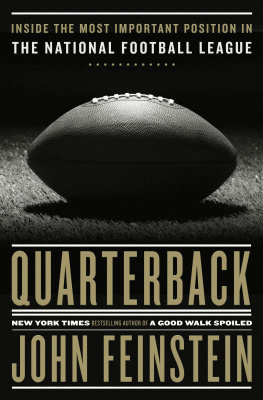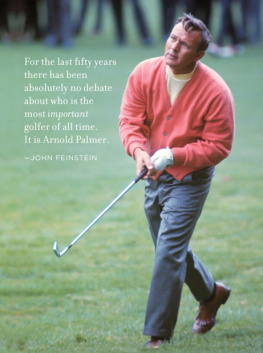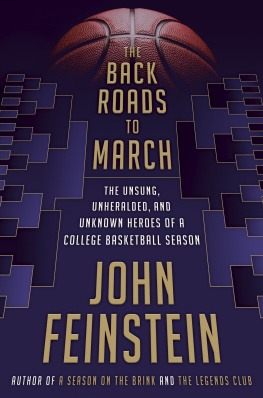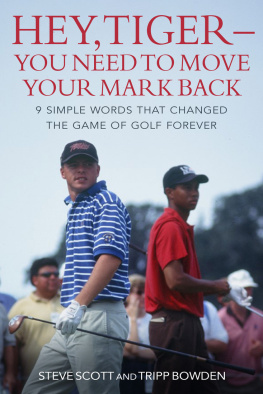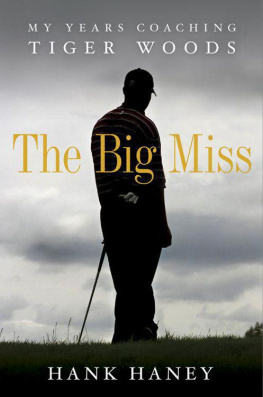T HE L IBRARY OF C ONTEMPORARY T HOUGHT
Americas most original voices
tackle todays most provocative issues
J OHN F EINSTEIN
T HE FIRST C OMING
Tiger Woods: Master or Martyr?
Now twenty-two, he is indescribably wealthyhis endorsement deals with Nike, Titleist, and American Express alone are worth close to $100 millionand there is no material item on the planet that he cant have. Whats more, he is making all this money playing a game he loves; living out a dream that has been part of his life for as long as he can remember.
Therein lies the problem. If there is one thing in his life that Tiger cannot own outright, it is his dream. He has to share that. He shares it with a father who honestly believes that he is responsible for Tigers greatness. He shares it with a management company that sees him as a money machine that must be pumped dry before he escapes. He shares it with corporate sponsors who expect time, charm, and victories in return for their millions. And he shares it with a public that wants him to be the sweet, sensitive guy it sees in his commercials and is shocked and dismayed when he turns out to be a twenty-two-year-old who tells dirty jokes, stamps his foot when he doesnt get his way, and stalks angrily off golf courses when he shoots 74.
The Library of Contemporary Thought
Published by The Ballantine Publishing Group
Copyright 1998 by John Feinstein
All rights reserved under International and Pan-American Copyright Conventions. Published in the United States by The Ballantine Publishing Group, a division of Random House, Inc., New York, and simultaneously in Canada by Random House of Canada Limited, Toronto.
http://www.randomhouse.com
Library of Congress Cataloging-in-Publication Data
Feinstein, John.
The first coming : Tiger Woods, master or martyr / John Feinstein.1st ed.
p. cm.
eISBN: 978-0-307-76697-7
1. Woods, Tiger. 2. GolfersUnited StatesBiography
I. Title.
GV964.W66F45 1998
796.352092dc21
[B] 97-52660
v3.1
Contents
D AY ONE OF the 1997 United States Open.
At exactly noon, Tiger Woods, once known as Eldrick, now known as golfs messiah, stepped onto the first tee at the Congressional Country Club with playing partners Steve Jones and Tom Lehman. Jones was the defending Open champion. Lehman was the reigning British Open champion. Among the thousands pressed against the gallery ropes, five and six deep from tee to green, there might have been a hundred who were there to see the two Open titleholders.
Everyone else had come to see Tiger. He was twenty-one years old, a multi-multi-millionaire, and already a one-name athlete, as in Michael or Shaq, Deion or The Shark. Only, at that moment Tiger was bigger than all of them. Even Michael. He was nine weeks removed from one of the most stunning performances in the history of sports, a twelve-shot victory in the Masters that had left people in golf groping for words to describe what they had seen. And what they had seen was impossible. Hes a boy among men, Tom Watson had said at the time. And hes teaching the men a lesson.
The Masters had elevated Woods to a level of fame that perhaps no athlete other than Muhammad Ali had ever achieved. People who knew absolutely nothing about golf, cared not at all about the sport, stopped to watch Tiger play. Children who once wanted to be like Mike and slam-dunk from the free-throw line now wanted to be Tiger and hit 350-yard drives. He signed endorsement contracts for staggering amounts of money. He blew off the president of the United States and Rachel Robinson, the widow of the centurys most important athleteand made no apologies for it. He didnt have to. He was Tiger. They werent.
His arrival on the grounds of Congressional at the start of the week had made a presidential motorcade look understated. Every time he moved, thousands moved with him. He was surrounded by so many security people that even other players were hesitant to approach him for fear they might get knocked backward by a large, unsmiling man in sunglasses. Miraculously, Woods seemed perfectly at ease with it all. At one point, lingering on the driving range while dozens of media types stood at a respectful distance, Woods looked at a couple of friends and said, Watch this.
He took five steps to his left, as if to leave the range. The security force immediately began to form a wedge, advance men flying toward the ropes to clear the area lest some fan momentarily impede Tigers exit. The media also began moving. Cameras were hoisted onto shoulders, tape recorders began whirring, notebooks were scribbled in. Then Tiger stopped. The wedge stopped instantly. The media, of course, also stopped. Tiger smiled, turned, and walked back to where he had been standing. It was a remarkable display of absolute power.
Now, three days later, Woods stood on the first tee, appearing cool, calm, and collected. After Ron Read, the United States Golf Associations (USGA) official starter, had introduced him, Woods gave the cheering throngs his now-trademark thousand-watt smile and set up over his ball. His club came back in the long, graceful arc that even his fellow pros envy, and then it came down, whipping through the hitting area with such force that the nearby grandstand seemed likely to start shaking. The ball climbed into the sky, becoming a tiny dot against; the fluffy clouds overhead; it hung there while all the spectators gaped, and then it came down 290 yards awayit was just a 3-woodon the right side of the fairway. As soon as it rolled to a stop on the short grass, the gallery exploded in appreciation. Woods reached down, plucked up his tee, and began marching down the fairway He was the eye of the hurricane, cameramen and photographers scrambling to record his every step, fans cheering and applauding and calling his name as he, Lehman, and Jones moved toward their tee shots. If Lehman or Jones had keeled over in the middle of the fairway, its possible that no one would have noticed.
When it was his turn to hit, Woods looked carefully at the green, now less than 150 yards away, consulted at length with his caddy, Mike Fluff Cowan (who had become a huge celebrity himself, thanks to his bosss success), and then took a long time before selecting a wedge for his second shot. It is an understatement to call Woods deliberate. All around America, young golfers are now learning to play the game ve-e-ry slo-o-wly because they are mimicking Woods. Finally he set up over his ball, took the club back in the same gorgeous arc, and gently lofted the ball in the direction of the green. When it came down, it hit and spun to a halt no more than six feet from the pin. The crowd exploded yet again. Woods smiled once more as Fluff handed him his putter.
In the press tent, Gary Van Sickle of Sports Illustrated shrugged. Thats it, he said. Its over. Put his name on the trophy.
Van Sickle was joking. Well, half joking. But he wasnt the only person on the grounds thinking that way. When it was Woodss turn to attempt his birdie putt a few minutes later, he surveyed the putt from every possible angle. When he got over the ball, he took one, two, three practice putts. Marriages have started, ended, and restarted in the time it takes Woods to line up a putt. Finally he pulled the trigger. The crowd prepared to roar again. But somehow the ball squirted right. Woods stared at it for a moment, as if it must have gone out-of-round to stay out of the hole.


